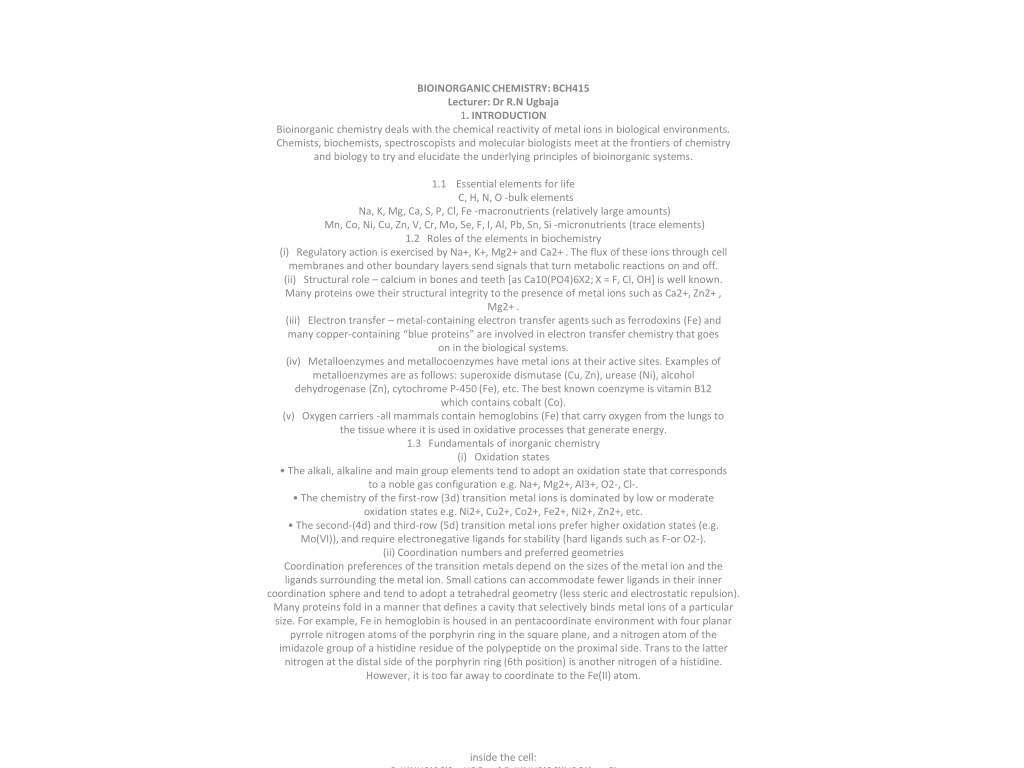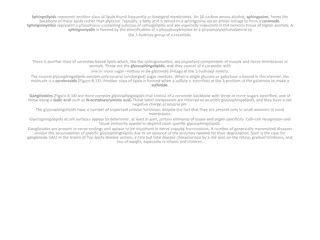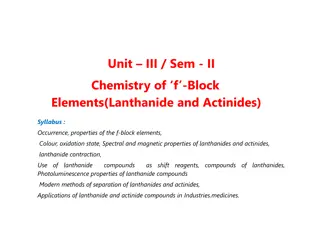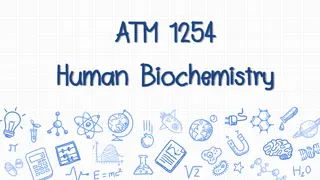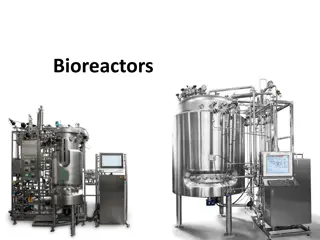Exploring Bioinorganic Chemistry: Essential Elements and Structural Functions in Biological Systems
Bioinorganic chemistry focuses on the reactivity of metal ions in biological settings, with essential elements like C, H, N, O, and various mineral macro and micronutrients playing key roles in regulatory, structural, electron transfer, enzyme function, and oxygen transport processes. Understanding the coordination preferences, ligand interactions, and pH influences on metal ions in biochemistry forms the basis of this interdisciplinary field.
Download Presentation
Please find below an Image/Link to download the presentation.
The content on the website is provided AS IS for your information and personal use only. It may not be sold, licensed, or shared on other websites without obtaining consent from the author. Download presentation by click this link. If you encounter any issues during the download, it is possible that the publisher has removed the file from their server.
Presentation Transcript
BIOINORGANIC CHEMISTRY: BCH415 Lecturer: Dr R.N Ugbaja 1. INTRODUCTION Bioinorganic chemistry deals with the chemical reactivity of metal ions in biological environments. Chemists, biochemists, spectroscopists and molecular biologists meet at the frontiers of chemistry and biology to try and elucidate the underlying principles of bioinorganic systems. 1.1 Essential elements for life C, H, N, O -bulk elements Na, K, Mg, Ca, S, P, Cl, Fe -macronutrients (relatively large amounts) Mn, Co, Ni, Cu, Zn, V, Cr, Mo, Se, F, I, Al, Pb, Sn, Si -micronutrients (trace elements) 1.2 Roles of the elements in biochemistry (i) Regulatory action is exercised by Na+, K+, Mg2+ and Ca2+ . The flux of these ions through cell membranes and other boundary layers send signals that turn metabolic reactions on and off. (ii) Structural role calcium in bones and teeth [as Ca10(PO4)6X2; X = F, Cl, OH] is well known. Many proteins owe their structural integrity to the presence of metal ions such as Ca2+, Zn2+ , Mg2+ . (iii) Electron transfer metal-containing electron transfer agents such as ferrodoxins (Fe) and many copper-containing blue proteins are involved in electron transfer chemistry that goes on in the biological systems. (iv) Metalloenzymes and metallocoenzymes have metal ions at their active sites. Examples of metalloenzymes are as follows: superoxide dismutase (Cu, Zn), urease (Ni), alcohol dehydrogenase (Zn), cytochrome P-450 (Fe), etc. The best known coenzyme is vitamin B12 which contains cobalt (Co). (v) Oxygen carriers -all mammals contain hemoglobins (Fe) that carry oxygen from the lungs to the tissue where it is used in oxidative processes that generate energy. 1.3 Fundamentals of inorganic chemistry (i) Oxidation states The alkali, alkaline and main group elements tend to adopt an oxidation state that corresponds to a noble gas configuration e.g. Na+, Mg2+, Al3+, O2-, Cl-. The chemistry of the first-row (3d) transition metal ions is dominated by low or moderate oxidation states e.g. Ni2+, Cu2+, Co2+, Fe2+, Ni2+, Zn2+, etc. The second-(4d) and third-row (5d) transition metal ions prefer higher oxidation states (e.g. Mo(VI)), and require electronegative ligands for stability (hard ligands such as F-or O2-). (ii) Coordination numbers and preferred geometries Coordination preferences of the transition metals depend on the sizes of the metal ion and the ligands surrounding the metal ion. Small cations can accommodate fewer ligands in their inner coordination sphere and tend to adopt a tetrahedral geometry (less steric and electrostatic repulsion). Many proteins fold in a manner that defines a cavity that selectively binds metal ions of a particular size. For example, Fe in hemoglobin is housed in an pentacoordinate environment with four planar pyrrole nitrogen atoms of the porphyrin ring in the square plane, and a nitrogen atom of the imidazole group of a histidine residue of the polypeptide on the proximal side. Trans to the latter nitrogen at the distal side of the porphyrin ring (6th position) is another nitrogen of a histidine. However, it is too far away to coordinate to the Fe(II) atom. inside the cell: PtII(NH3)2Cl2 + H2O -> [ PtII(NH3)2Cl(H2O)]+ + Cl
Figure 1. A representation of one of the sub-units of hemoglobin. The continuous black band represents the peptide chain and the various sections of the helix. Dots on the helical chain represent a-carbon atoms. The heme group is near the top of the diagram, with the iron atom represented by a large dot. The coordinated histidine is labelled F8, meaning the 8th residue of the F helix. (iii) Ligand preference (based on hard-soft acid-base (HSAB) theory) Hard metal ions (e.g. Fe3+, Mn2+) can be selectively ligated by small hard anions, of which alkoxide (RO-) derivatives (e.g. tyrosinates, hydroxamates, and catecholates) are the only reasonable candidates at biological pH. Softer metal ions (e.g. Cu2+, Ni2+, Zn2+, Fe2+) are preferred by the soft ligands such as imidazole and thiolate ligands. If a hard metal is combined with a soft ligand, the metal does not readily accept the electron density being offered by the ligand, and so the resulting complex is less stable since both partners are incompatible. As a general rule, the affinity of a donor atom in a ligand for a hard metal ion varies as follows: F > O > N > Cl > Br > I > C ~ S. This order is reversed for soft metals. (iv) Influence of pH Competition between metal ions and the protons is active, particularly when ligands derive from ionized functionality. However, at neutral pH, the formation constants of transition metals are usually greater than the acidity constants (Ka) that correspond to the affinity of a ligand for a proton. In some intracellular compartments, the pH can be lowered from the normal physiological level of 7.4 to a pH of 5.5, and this is used to facilitate the release of iron from transferrin (iron transporting protein). (v) Ligand field stabilization energy Metal ions may derive extra stability when bound by ligands as a result of the orbital splitting. The sum total of the contributions from all d-electrons is termed the ligand field stabilization energy (LFSE). For example, a low spin d6 system (Fe2+) results in a large LFSE in octahedral environments, as well as the d3 system (Cr3+). Figure 2. Loss of d-orbital degeneracy in a variety of ligand field geometries. (vi) Kinetics and mechanisms of reactions involving metal complexes In biology, the ligand environments of metal ions are often in a state of change. For example, the activation of the protein calmodulin by Ca2+ requires the replacement of calcium-bound water molecules by protein ligands. The exchange of ligands at metal centers plays a role in the regulation of cellular metabolism. For example, the rapid ligand exchange rates of Ca2+ (Kex ~ 109 s-1) relative to Mg2+ (Kex ~ 105 s-1) explains the selection of the former as a secondary messenger system. The knowledge of the reaction mechanisms for substitution of metal bound ligands is essential for proper understanding of inorganic biochemistry. Interchange mechanisms may be termed dissociative (Id) or associative (Ia), where the coordination numbers of the metal center formally decrease or increase, respectively.
(vii) Electron transfer reactions In biological redox chemistry, a substrate molecule usually binds directly to the metal center. For example, the reduction of nitrate to nitrite by the molydoenzyme, nitrate reductase, proceeds via transfer of electrons from Mo(IV) to nitrate after the latter binds to the former. 1.4 Fundamentals of biochemistry (i) Biological ligands Proteins constitute one of the basic functional units in biology. The proteins are built-up of amino acids, and the terminal groups (side chains) provide the ligating atoms. Figure 3. Twenty common amino acids There are 20 common amino acids, and a protein backbone is formed from a basic set of amino acids by formation of amide links between the amino and carboxylic acid functionality. Figure 4. Left-Formation of polypeptide chain by amide (peptide) bond formation. Right-The metal-binding domain of Ca2+-activated enzyme (phospholipase A2) showing coordination of a chelating carboxylate, two water molecules, and three backbone carbonyls. (ii) Polynucleotide Structure RNA and DNA are constructed from nucleic acids as building blocks, which are derived from five bases, adenine, guanine, cytosine, thyamine or uracil, and are attached to a ribose sugar (RNA) or deoxyribose (DNA) ring by an N-glycosidic linkage, and a phosphate group is attached to the sugar. DNA typically exists in a form of a double-stranded structure formed by hydrogen bond formation between specific base pairs. Figure 5: Left-Structural units of nucleic acids. Middle-A single and a double-stranded DNA. Right-Specific hydrogen bond patterns formed between complementary base pairs. The negatively charged sugar-phosphate backbone of the major and minor grooves of DNA play host to a variety of charged species (e.g. metals, ligands and protein side chains). Alkali and alkaline earth metals tend to coordinate to the oxyligands (phosphate, sugar hydroxyls, and carbonyl functionality), whereas softer transition metals preferentially coordinate to the heteroatoms N and O on the base units. The principal metal-binding domains on nucleotides are illustrated in the following: 1.5 The role of model systems (synthetic mimics) Because of the size and complexity of most biochemical molecules and processes, it is often advantageous to find smaller and simpler models upon which controlled experiments can be more easily performed, and with which hypotheses can be tested. Bioinorganic chemistry has been an especially fruitful area for the use of model systems, especially where transition metals are involved. However, overly simplistic models can be dangerously misleading. Even in the best of circumstances, a model can give only a partial view of how the real system works. The broad and detailed knowledge of the coordination chemistry that we have sets the stage for an understanding of the role of metal ions in biological systems. Fundamental principles and generalisations about the behaviour of metal complexes are valid whenever the metal is coordinated by some relatively simple set of man-made ligands or by a gigantic protein molecule where the coordinating groups are often carboxyl oxygen atoms, thiol sulphur atoms or amine nitrogen atoms. Throughout this course, we shall frequently refer to model systems that have played a role in understanding real bioinorganic systems. Tutorial 1 1. Use examples of your choice to discuss the role of metals in biological systems. 2. Write brief explanatory notes on the fundamentals of both inorganic chemistry and biochemistry that influence bioinorganic systems. 2. HEMOGLOBIN (OXYGENATION) Living systems can use O2 for controlled oxidation to supply the energy they need. Hemoglobin is an O2 carrier in mammals from the lungs to the tissue. It is remarkable that O2 does not oxidize hemoglobin, considering the redox potentials for the reduction of O2 and oxidation of Fe2+ . The reversible binding of O2 in hemoglobin is due to the unique features of the porphyrin ring system and the hydrophobic blocking of the large protein (globin). It will be discussed in detail. Figure 6: A porphyrin ring system with coordinated iron (heme group).
The molar mass of hemoglobin is about 64,500. There are four subunits (a2 2) each of which contains one heme group (an iron complex of porphyrin), associated with the protein globin. Two of the subunit proteins form alpha (a) chains of 141 amino acids, and two form beta ( ) chains of 146 amino acids. The chains are coiled so that a histidine side chain is coordinated to Fe on the proximal side of the porphyrin ring. The sixth site is occupied by O2 in oxyhemoglobin (upon oxygenation); in deoxyhemoglobin it is vacant or substituted by H2O. 2.1 Dioxygen as a ligand and the oxygenation process Consider the molecular orbitals of O2 to understand its properties as a ligand: If 92 kJ/mol of energy is supplied, the spin-pairing can occur, then the other 2pp* orbital becomes empty. O2 is therefore a mild p-acceptor ligand, and it coordinates in a bent end-on fashion to Fe(II) at the distal side of the porphyrin. The mechanism of oxygenation can be explained by considering the coordination chemistry involved. Deoxyhemoglobin has a high-spin distribution of electrons, with one electron occupying the dx2-y2 orbital that points directly to the four porphyrin nitrogen atoms. The presence of this electron in effect increases the radius of the iron atom in these directions. Repulsion with the lone pair electrons of the nitrogen atoms results in an iron atom lying ~0.75 out of the plane of these nitrogen atoms. Figure 7: The deoxy and the oxy forms of hemoglobin. When an oxygen molecule becomes bound to the iron atom in the sixth position (opposite the imidazole nitrogen atom), the ligand field is strong enough to cause spin-pairing, giving a low-spin (d6) system which the six d-electrons occupy the three t2g orbitals( dxy, dxz, dyz). The dx2-y2 orbital is then empty and the previous effect of an electron occupying this orbital in repelling the porphyrin nitrogen atoms vanishes. The iron atom is thus able to slip into the centre of an approximately planar porphyrin ring and an essentially octahedral complex is formed. The four pyrrole nitrogens of the highly conjugated porphyrin macrocycle form s bonds with the iron, while the p system interacts with the metal t2g electrons. The presence of the vinyl substituents is proposed to cause the withdrawal of p-electron density from the porphyrin ring, thereby strengthening the iron to porphyrin nitrogen p bonds (enhanced p back-bonding), and thereby weakens the bonds of the axial ligands and therefore the sixth position. However, the mutual interaction between the axial ligands is influenced by the trans effect . The more basic imidazole nitrogen at the proximal side displaces more electron density to the trans position to strengthen the Fe-O2 bond (promotes oxygenation). 2.2 Reversible oxygenation Fe(II) heme which is not attached to the globin (protein) cannot bind oxygen in aqueous solution, but instead is oxidized to the Fe(III) form which no longer binds O2. The influence of the distal nitrogen and the globin part is in such a way to avoid too much electron transfer from the Fe(II) to the O2. The distal nitrogen limits the size of the sixth coordination site, so that the bonding mode of O2 is bent, which lowers the affinity for e-density from Fe(II) and promotes reversibility. The hemes are bound in cavities which are surrounded by hydrophobic groups and this low dielectric constant millieu inhibits charge separation which occurs upon oxidation and such an environment is required for reversible oxygenation. 2.3 Hemoglobin cooperativity As the iron atom moves upon oxygenation (from a tensed unligated deoxy form to the relaxed ligated oxy form), it pulls the imidazole side chain of histidine F8 with it, thus moving the ring about 0.75 .. This shift is then transmitted to other parts of the protein chain to which F8 belongs. In particular, a large movement of the phenolic side chain of tyrosine HC2 is produced. The result is that various shifts of atoms in the neighbouring subunits are caused and these shifts influence the oxygen-binding capability of the heme group in that unit. Although the four heme sites are well- separated, movement of one chain affects the conformations of the other significantly, and the cooperativity of hemoglobin is achieved during oxygenation.
Hemoglobin then transports O2 to the muscles where it is transferred to myoglobin for storage until needed for energetic processes. Myoglobin, although similar to one of the sub-units of haemoglobin, binds O2 more strongly than does hemoglobin, particularly at low concentrations of O2 and high concentrations of CO2 (low pH) that exist in active muscles. After the first O2 molecule is transferred by haemoglobin, the others are released even more easily because of the cooperative effect in reverse. 2.4 Hemoglobin Modeling (synthetic models) The ability of the heme in hemoglobin to bind an O2 molecule and later release it without the iron atom becoming permanently oxidized to the iron(III) state is essential to the functionality of these oxygen carriers. It is the reversibility of the hemoglobin reactions with O2 that must be matched with any useful model. Early studies of hemoglobin models encountered problems of irreversible oxidation, resulting in the formation of the Fe(III)-O-Fe(III) dimers. Such systems include [Fe(II)(TPhPor)(2-MeIm)], which was formed as follows: Cr(II) 2-MeIm [Fe(III)(TPhPor)Cl] ------ Fe(II)(TPhPor)-----------[Fe(II)(TPhPor)(2-MeIm)] Ethanol 2-MeIm = 2-methylimidazole; TPhPor = tetraphenylporphyrinato [Fe(II)(TPhPor)(2-MeIm)] is very similar to deoxyhemoglobin, it is five-coordinate and the iron atom is 0.55 from the mean of the porphyrin. In hemoglobin, the bulk of the protein surrounding the heme units assures that each unit remains isolated in its pocket, which is limited in size. An effective model would be the one that approximates the same degree of bulk. Baldwin achieved reversible O2 addition with an Fe(II)porphyrin complex, using a porphyrin with a bridge involving a benzene ring over the centre of the porphyrin ring ( capped heme model). With a N-methylinidazole coordinated below the porphyring ring, the O2 could be added reversibly below the cap. After several hours, irreversible oxidation of the oxygenated capped porphyrin formed the oxo-bridged dimer. Collman developed picket fence model compounds such as [Fe(TpivPhPor)(N-MeIm)2] which can be completely oxygenated in solution to form [Fe(TpivPhPor)(N-MeIm)(O2)], which were kinetically stable for prolonged periods. By cooling, analytically pure crystalline dioxygen complexes could be isolated. Figure 8: The capped and the picket fence heme models Tutorial 2 Discuss the concept of oxygenation that is achieved by haemoglobin for oxygen transportation. Give particular emphasis to dioxygen as a ligand, the coordination chemistry involved, the role of some structural features to reversible oxygenation, and haemoglobin cooperativity. 3. VITAMIN B12 The vitamin was isolated from liver after it was found that eating raw liver would alleviate pernicious anaemia. Pernicious anaemia is a blood disorder caused by lack of vitamin B12. Patients who have this disorder do not produce a protein (intrinsic factor) in the stomach that allows the body to absorb vitamin B12. Symptoms include shortness of breath, fatigue, loss of appetite, diarrhea, numbness of hands and/or feet, sore mouth, and bleeding gums. Vitamin B12 is a coenzyme and its deficiency leads to the dissfunction of cobalamin-dependent enzymes such as methylmalonyl-coenzyme A mutase (MCM) and glutamate mutase. Methylmalonyl-coenzyme A catalyses the isomerisation between methylmalonyl-coenzyme A and succinyl-coenzyme A, while glutamate mutase catalyses the reversible interconversion of L-glutamate and L-3-methylaspartate. MCM is also involved in the degradation of several amino acids, odd-chain fatty acids and cholesterol. Hydroxycobalamin, methylcobalamin or cyanocobalamin are now used for treatment of pernicious anaemia. 3.1 Structure of Vitamin B12 In Vitamin B12, the Co atom is coordinated to a corrin ring (macrocyle similar to the porphyrin ring). On one side of the corrin ring, the ligand bonded to Co is a-5,6-dimethylbenzimidazole nucleotide, which is also joined to the corrin ring. The active form of the vitamin, called coenzyme B12, contains an adenosyl group as the sixth ligand, while it is called cyanocobalamin with CN-as
Figure 9: (a) Vitamin B12, (b) The adenosyl group which is present in place of CN-in coenzyme B12. 3.2 Stabilization of the Co-C Bond The coenzyme contains a Co-C s bond and is a cobalt(III) compound. Thermochemical data indicate that transition-metal-carbon bonds are considerably stronger (100-200 kJ/mol) than had been realized earlier, though still somewhat weaker than M-F, M-OR or M-Cl bonds (300-400 kJ/mol). Alkyls are therefore good s donors and are capable of stabilizing high oxidation states such as Co(III). The instability of metal alkyls thus is of kinetic rather than thermodynamic origin, and so the species can be stabilized by blocking reaction pathways. Hence, ligands that are strongly bonded, and occupy all coordination sites stabilize the alkyls. Co(III) in cobalamin is a d6 system and with ligands such as the corrin nitrogens and the imidazole nitrogen (a strong ligand field will result), the ion will form strong s and p bonds with the ligands. The bonding of the alkyl group at the sixth position completes the octahedral coordination sphere. 3.3 Co-C Bond Cleavage There are three possible ways in which the Co-C bond can be broken in alkylcobalamines: Heterolytic bond cleavage: Co(III)-R --------------- Co(III) + :R-(carbanion) (1) Homolytic bond cleavage: Co(III)-R ---------------Co(II) + R (alkyl radical) (2) Heterolytic bond cleavage: Co(III)-R ---------------Co(I) + R+ (carbocation alkyl moiety) (3) (2) and (3) are one step reductive elimination processes which are reversible under physiological conditions via oxidative addition of alkyls from alkyl halides. 3.4 Models of B12 The cobalt complex of dimethylglyoxine is an effective model for B12. The reactions shown by adenosyl and alkyl cobaloxime derivatives, which resemble those of B12, include methyl group transfer, reduction and rearrangements. Figure 10: Picture of pyridine cobaloxime. Tutorial 3 (a) The existence of a relatively inert bond between Co(III) and a primary alkyl ligand (in alkylcobalamins) under physiological conditions is quite remarkable. Interrogate this statement with regards to the coordination chemistry involved. (b) Discuss the possible ways for the cleavage of the Co-C bond.
4. NITROGEN FIXATION The importance of the inorganic-biological nitrogen cycle for life on earth can hardly be overestimated. The importance of nitrogen compounds as fertilizers in agriculture may be taken from the fact that ammonia continues to be one of the leading products of the chemical industry, other large-scale chemicals such as ammonium nitrate, urea, and nitric acid are follow-up products of the industrial fixation of nitrogen as obtained from air. Most of the biological systems which participate in the global nitrogen cycle contain metal- requiring enzymes. Three main processes can be distinguished in the nitrogen cycle: nitrogen fixation, nitrification and denitrification. N2 + 3H2 >400 C > 100 bar 2NH3 nitrogen fixation (industrial) Fe catalyst N2 + 10H+ + 8e nitrogenase 2NH4+ + H2 (biological nitrogen fixation ) NH4+ + 2O2 nitrification NO3 +H2O+2H+ 2NO3- + 12H+ + 10e- denitrification N2 + 6H2O from biomass Nitrogenase has been found to contain two components, a Mo-Fe-containing protein and an Fe- containing protein. The Mo-Fe protein contains two Mo and about 30 atoms each of Fe and sulfide (molar mass 220,000). The Fe protein contains two identical subunits, each containing an Fe4S4 cluster (molar mass 60,000). Presumably, N2 is complexed by the Mo and the Fe protein, bringing about reduction through electron transfers. Adenosine triphosphate (ATP) is essential for nitrogenase activity. The discovery of stable complexes of N2 led to intense study of model compounds and a possible new nitrogen fixation process. Ammonia has been obtained from metal complexes of N2. 4.1 Non-biological N2 fixation (i) Dinitrogen as a ligand Consider the molecular orbitals of N2. N2 has a triple bond and hence the high dissociation energy of 940 kJ/mol. It also has a symmetrical e-distribution and absence of polarity. The lowest vacant molecular orbitals are the two degenerate antibonding p orbitals at -676 kJ, which are too high in energy to be attacked by any but the strongest reducing agents, such as the more electropositive metals. This explains the rapid nitriding of the Li wire (for CO, the two 2pp* orbitals are at -772 kJ/mol, and therefore low in energy, hence CO is a better p acceptor than N2). The highest energy orbital containing electrons (2ps) at -1505 kJ is too low in energy to give up electrons to any stable electron acceptor, such as molecular oxygen at room temperature (for CO it is at -1354 kJ/mole, therefore CO is a better s donor). Therefore, N2 is a weaker s donor and a weaker acceptor of eletrons than CO). N2 is stable because of the high energy gap between the LUMO and HOMO, and hence the inertness of molecular dinitrogen (N2). (ii) Important parameters in the stability of N2 complexes 1. Spin-pairing, high covalent character is a prerequisite. 2. the nature of the transition metal (the second and third period transition metals have better covalent bonding capabilities). 3. The significance of the coligands (i.e. they must not be too strongly p-accepting like CO, s donation results in strong M-N bonds). Strong p acceptors will contract the d-electron cloud and decrease p backbonding. Stereochemistry also plays a role (i.e. whether the coligands are bulky or not). Also, the trans-effect and its influence play a significant role. 4. Oxidation state of the metal ion is important, a low ox-state, reducing medium is needed for effective p-backdonation into the N2 moiety. (iii) Preparation of dinitrogen complexes Directly from dinitrogen: Involves the reaction of N2 with a pre-formed and isolated complex by replacement of labile neutral or anionic ligands by N2 (or by a single step reaction of a suitable complex with a reductant under N2).
need a strong reducing agent like Mg to expand the d-cloud of the Mo (in effect it reduces Mo(III) to Mo(0)) and a low oxidation state is obtained which is a prerequisite for dinitrogen fixation. Mo is a 4d metal and therefore also has good covalent bonding capabilities. thf is a cyclic ester and does not bond strongly to the metal and is readily replaced by dppe which is a good coligand since it is a mild p-acceptor and a chelate, and hence will not compete with N2. Cl-is electronegative (high EN) and will contract the d-cloud of the metal and is a p-acceptor, and hence will compete with dinitrogen and must therefore be replaced. Indirect method: Dinitrogen can be generated by reaction at a coordinating N moiety (e.g. oxidation of bonded hydrazine) M(I) is a thermodynamically and kinetically stable low spin d6 system (M=Mn) Even the strong p-acceptor CO is a coligand since the Cp-pushes a lot of e-density into the d- cloud of the metal (Cp-is probably trans to the N2 so that p-backbonding to N2 can occur effectively even in the presence of CO). H2O2 is a strong oxidising agent, it oxidises bonded hydrazine to dinitrogen. M-N2H4 + 2 H2O2 ------------ M-N2 + 4H2O
Tutorial 4 (a) Comment on the inertness of N2. (b) Mention a few metal-containing inorganic systems (both biological and non-biological) that can bind the unreactive dinitrogen. Discuss the coordination chemistry involved in these systems. 5. ROLE OF METALS IN MEDICINE There are an astonishing number and variety of roles that metals play in contemporary medicine. This section contains information on the medicinal uses of inorganics, that is, of elements such as iron, lithium, to name a few, as well as metal-containing species such as auranofin (Au). In keeping with the notion that healthy mammals rely on (bio-essential) metals for the normal functioning of approximately a third of their proteins and enzymes, a large number of drugs are metal-based and considerable effort is being devoted to developing novel metal-based drugs. While there is no doubt that there is an emphasis on 'metallotherapeutics', the use of metals in medicine is not restricted to metal-based drugs. The following are also find applications of metals in biology: non-invasive radiopharmaceuticals (e.g. technetium-based radiopharmaceuticals) Magnetic Resonance Imaging (MRI) (e.g. gadolinium-based paramagnetic contrast agents). mineral supplements (e.g. calcium supplement for bone growth). There has been an appreciation of the role metal-based drugs play in modern medicine and a considerable effort is currently devoted to the development of novel complexes with greater efficacy as therapeutic and diagnostic agents. Selected examples of metallotherapeutics and metal-based diagnostic agents: Auranofin (Au) used for treatment of arthritis Cisplatin and carboplatin (Pt) testicular and ovarian cancer Oxaliplatin (Pt) colorectal cancer Myoview (Tc) heart imaging Ceretec (Tc) brain imaging Tc-MDP (Tc) bone imaging Other metals in medicine: Iron supplement for iron deficient anemia Zinc supplement for normal growth Lithium bipolar affective disorder Boron boron neutron capture therapy (BNCT) Selenium treatment of liver, prostate and bladder cancer Rhenium palliative treatment of bone pain Vanadium treatment of diabetes (current research) Gold anticancer (current research) With regard to the metal complexes, it is the coordination chemistry of these metals that determines the in vivo stability and action of these drugs. With regards to diagnosis, target specificity is a requirement, and therefore the ligands act as shuttles but the physical nature of the metal plays a role. We shall discuss in detail only the chemistry involved in platinum complexes as chemotherapeutic anti-cancer agents, and in particular the action of cispatin will be discussed.
5.1 Modes of Action of Cisplatin The discovery of cisplatin (cis-diamminedichloroplatinum, or cis-DDP) in the early 1960s generated a tremendous amount of research activity as scientists strove to understand how the drug worked in the human body to destroy cancer cells. We now believe that cisplatin coordinates to DNA and that this coordination complex not only inhibits replication and transcription of DNA, but also leads to programmed cell death (called apoptosis). As it turns out, however, formation of any platinated coordination complex with DNA is not sufficient for cytotoxic (that is, cell-killing) activity. The corresponding trans isomer of cisplatin (namely, trans-DDP) also forms a coordination complex with DNA but unlike cisplatin, trans-DDP is not an effective chemotherapeutic agent. Due to the difference in geometry between cis-and trans-DDP, the types of coordination complexes formed by the two compounds with DNA are not the same. It appears that these differences are critically important in determining the efficacy of a particular compound for the treatment of cancer. For this reason, a great deal of effort has been placed on discovering the specific cellular proteins that recognize cisplatin-DNA complexes and then examining how the interaction of these proteins with the complexes might lead to programmed cell death of cancer cells. (i) Cellular Uptake of Cisplatin Before we describe the interactions of cisplatin in the cell, we need to understand how it gets there. Cisplatin is administered to cancer patients intravenously as a sterile saline solution (that is, containing salt specifically, sodium chloride). Once cisplatin is in the bloodstream, it remains intact due the relatively high concentration of chloride ions (~100 mM). The neutral compound then enters the cell by either passive diffusion or active uptake by the cell. Inside the cell, the neutral cisplatin molecule undergoes hydrolysis, in which a chloride ligand is replaced by a molecule of water, generating a positively charged species, as shown below and in Figure 1. Hydrolysis occurs inside the cell due to a much lower concentration of chloride ion (~3-20 mM) and therefore a higher concentration of water.
